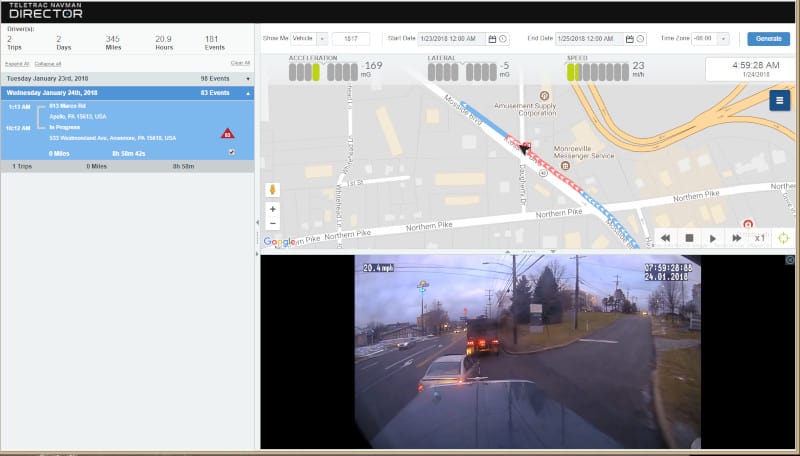As fleets adopt more advanced safety system, the issues of initial and ongoing driver training become the primary vehicle to the success of those system. Marco Encinas, global platform product manager for Teletrac Navman, tells FreightWaves that without that continued support, fleets will not get the overall benefits of the system.
“You can put all the technology in the world in the cab, but unless you follow up with proper training, [drivers] will fall back [to poor behaviors],” he says.
Teletrac Navman just introduced its Driver Safety Analytics solution, a fully integrated safety program that includes camera technology, driver scorecards, GPS tracking data and event replays and analytics all in a single dashboard. It is part of the company’s DIRECTOR platform.
“If you buy the components individually, you have to do all the work to analyze [the data],” Encinas says. The new system combines all the data and scores drivers, Encinas says, eliminating the manual work of pulling data from disparate systems and combining it for a full view of a driver’s behavior. It is fully customizable.

“We take all the different driving behaviors that are triggered …and when you have a camera installed, the camera takes a recording of that snippet in time,” he says.
That information can be used to help improve training programs, correct improper driver behavior, or even reward drivers. Encinas says some fleets use the information to create contests among drivers to encourage them to improve their driving performance, from safe driving techniques to fuel-efficient driving.
“The reporting component takes all these events and generates a score,” Encinas notes. “The next evolution of this technology is the camera will become a machine learning device” that can identify when a driver’s performance, such as a hard-braking event that might trigger an alert, may have been the correct decision in that scenario.
The DIRECTOR Safety Analytics module includes the following:
- The Integrated Event Viewer lets fleets simultaneously view driving event replays and unsafe behaviors on Google Maps, using GPS tracking data, and second-by-second Dashboard Camera video footage for quick response to and resolution of incidents.
- Front-Facing Dashboard Cameras continuously record HD quality video footage and stores recordings of all events in the cloud. In addition to getting a complete picture of events, footage can be used as supporting material in the event of an insurance claim and to protect against driver fault in accidents.
- Driver Scorecards track and rank driver improvements over time for personalized training, in combination with event replay and live footage, and to recognize positive driver behaviors.
- Reporting & Alerts measures speeding, harsh breaking, erratic cornering and other dangerous behaviors through GPS tracking and proactively alerts fleet managers. It lets fleet managers build dashboards around safety KPIs and do in-depth evaluation on fleet-wide and individual driver safety performance to easily communicate performance trends, create targeted improvement plans and build incentive programs that encourage safe driving
For safety conscious fleets, though, the addition of systems such as this are only part of the solution. The real success lies in the initial training and education on how to use it, and the continuation of that training and education to keep drivers engaged, many of whom resist the addition of cameras to their cab environment.
“From a fleet perspective, at the highest levels, we’ve seen good acceptance,” Encinas says. “From a driver perspective, we see pushback because drivers see [cameras] as Big Brother.”
Drivers tend to more accepting of cameras recording video outside the cab, especially when it can be explained to them how it helps.
“If it’s positioned where [fleets] are putting these tools in place to protect them [they are more accepting],” he says.
As an example, Encinas noted one fleet that deployed the system when from 17 at-fault driver incidents to just 8. The savings from those incidents alone would have paid for a driver incentive program for three years for the fleet. Additional savings are obtained through lower CSA scores, fuel savings, maintenance savings due to less wear and tear, etc.
Ultimately, the success of any program lies in the hands of the fleet.
“It’s about the ongoing training and ongoing support they give these drivers,” Encinas sums up.










